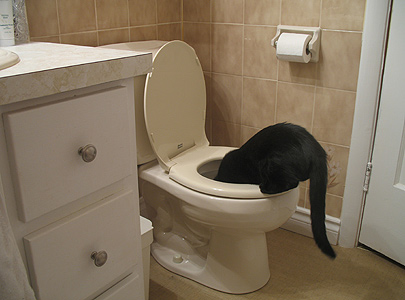|
Day 2: Attributing yesterday's incident to first-day jitters, I move the
contraption on to the toilet. Pepper uses it immediately and hits the mark on her first try. I
knew it was a good idea to make her sit through the LitterKwitter training video.
Days 3-5: Obviously, my cat is a prodigy. I'm thinking Letterman.
Day 8: So far, so good, although Pepper really likes to send the litter
flying. (The dog, clearly envisioning canine hors d'oeuvres, gets excited whenever we hear furious
scratching from the bathroom.)
I decide we can graduate to the next stage, which involves placing over the toilet a disc that
contains litter, but which also has an opening into the bowl. Pepper sticks her head through the hole and
peers at the water. Then she drinks some.
Days 9-12: Twice she slips and one hind leg goes into the water, but undaunted,
she learns to balance with all four feet on the outer rim. What a trouper!
Day 21: I decide to graduate her to the next disc. She is not happy
when she sees the much bigger hole. She looks incredulous, in fact. A few hours later, she pees
in the sink.
Day 23: Tell me that's not poop in the sink.
Day 25: With remedial work clearly required, I go back one stage and also order
the kit that has a couple of intermediate steps. The Litter-Kwitter site says it's back-ordered and won't be
in for at least a month.
Days 26-30: It takes nearly a week to get Pepper back on track, but I'm heartened
by the progress.
Day 37: I arrive home to discover that Pepper, who has become fascinated with
the bathroom, has knocked over a container of cosmetic brushes, pulled a pile of hand towels from the top of the
toilet tank on to the floor, slammed the toilet lid shut and sent Q-Tips flying all over. I lift the lid on
the toilet and find the cosmetic brushes inside.
Day 41: I read blogs on toilet training cats. While many trainers are
successful, some are still working on toilet training cats six months, even a year, after starting. Yikes.
Day 46: Pepper's been holding her Number 2s more than 24 hours. On a whim,
I go back to the disk with the much bigger hole. She hops up immediately, rearranges the litter a bit and poops
into the water. General jubilation. Dog looks disgusted.
Day 49: I discover someone (okay, me) left the toilet lid down. Pepper
did the only thing she could: She peed on the floor beside the toilet. Twice. While I'm scrubbing,
Pepper trots out to the sunroom, where her litter box used to be, and relieves herself on the tile floor.
Day 50-51: Pepper poops in the sunroom, although she pees in the toilet.
Should I give in? Backtrack?
Day 52: Pepper, after much coaching, resumes her use of the toilet for all
functions. I awaken to the sound of tinkling from the bathroom. "Good girl," I say,
groggily.
Day 53: Pepper hops onto the toilet while the training disc is off for cleaning
and uses the toilet without it. Much excitement.
Day 54: Yesterday's achievement seems forgotten.
Day 56: I review the LitterKwitter package, which says this entire process
should take "eight weeks or less." Hm.
Day 59: Pepper leaves another little pile in the sunroom. Later, I
discover one in the sink.
Day 60: Capitulation – mine, not hers. The litter box is back. Pepper
is very happy and uses it repeatedly. The bathroom is clean and the sunroom is clean, so I'm happy, too.
Deborah Read is a frustrated cat owner and an editor at the Star.
|
|
THEORETICALLY, IT'S POSSIBLE
How do you train your cat to use the toilet? You'll need perseverance, dedication,
mechanical aids – and a high tolerance for messy cleanups.
In theory, it's a series of easy, gradual steps known as "the disappearing litter box"
method: Move your cat's litter box (or facsimile, such as a plastic sitz bath or commercial kit) on to an open
toilet. Make a small hole in the "box." Gradually make the hole larger (as the cat comes to
realize that water is just as effective at "hiding" odour as litter). Eventually, take the
"litter box" away entirely. Voilà. A toilet-trained cat.
In practice, of course, the entire process will likely take months. And every time your cat
makes a "mistake," you'll be scrubbing or deodorizing or laundering something. For some people,
though, the end result – no more litter box – is worth it.
THE GEAR
Here are three home-training choices:
D.I.Y.
You can make your own toilet-training "setup" with a plastic sitz bath from the
drugstore or an aluminum roasting pan, duct tape, plastic homemade "litter dams" and reinforcing cardboard.
Cost: under $20.
Pros: It's cheap and you can make endless adjustments, or even replace the
set-up, depending on your cat's progress.
Cons: It's easy to make mistakes and spook your cat. Do your homework
before you start.
Website: An invaluable aid is the "T-Training" group at
http://pets.groups.yahoo.com/group/CatsT-Training/join (this website requires you to join
and sign in with a password).
CITIKITTY
A plastic insert with concentric rings that you cut away as your cat progresses.
Cost: $29 U.S. plus $11.70 shipping.
Pros: Best price for a commercial kit.
Cons: It's one-use only. If you cut away a ring and your cat balks, there's
no going back without duct tape.
Website: citikitty.com
LITTERKWITTER
A plastic ring that fits over the toilet bowl, with three inserts, two with increasingly larger
holes. Two additional rings are available for "slow learners."
Cost: $69 U.S. ($14.95 for extra rings), plus $5 shipping.
Pros: Easy to lift on and off the toilet and easy to clean.
Cons: The transitions between the rings are too abrupt for some cats.
Website:
litterkwitter.com
|
